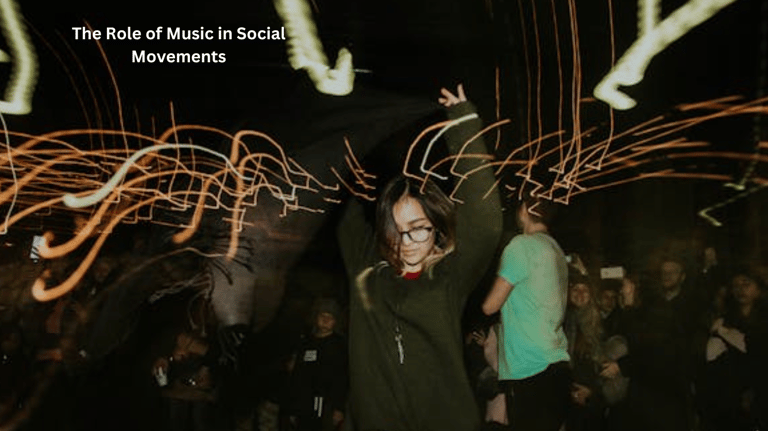The Role of Music in Social Movements Historical Accounts and Analyses
1/24/20255 min read


The Role of Music in Social Movements: Historical Accounts and Analyses
Music has always represented something other than an entertainment factor; it was a medium of change, the voice of the voiceless, and the catalyst that united in the moments of social uprisings. From the freedom songs of the Civil Rights Movement to the punk anthems that challenge the prowess of authority, music has evolved into a defining tool for the direction of societal narratives and steering progress. Let's go through historical accounts and analyses showing music's importance in social movements.
The Power of Song: A Historical Perspective
Music was entirely part of the social movement even in centuries past. It is said that during the 18th and 19th centuries, music became the anthem for labourers and enslaved people to help them have a feeling of hope and togetherness. For example, the enslaved African Americans used spirituals and work songs not merely to stammer through arduous labours but also forwarded coded instructions of the flight route in the Underground Railroad. One example of such a song is "Follow the Drinking Gourd", which clearly demonstrates the concept, which, through what was supposedly brilliance from an elevated hymn, allowed one to speak a veiled message.
Labour unions in America and Europe employed songs as the rallying call of workers during the early 20th century. Songs like "Solidarity Forever" became labour rights anthems organized across industries and countries. Besides adding morale to the striking and protesting workers, the songs also unified them to demand better working conditions.
Civil Rights and Sound of Change
Stepping forward to the 1960s, everything made sense about how music would alter everything in the American Civil Rights Movement. The wellsprings of life were gospel, soul, and folk. Such songs as "We Shall Overcome" and "A Change Is Gonna Come " provided solace and inspiration for activists who experienced violence and oppression. Not only did these songs boost spirits, but they also knew the plight and aspirations of millions.
Music was also another tool for organizing successfully. This event will display how music can help reinforce and etch a message into history.
This is the Woodstock generation of 1969. It was an event that brought together half a million people in peace and love for music. Jimi Hendrix's breaking performance exemplifies the powerful connection between music and activism; the notes and lyrics were less relevant than the emotions and ideas they evoked for all the listeners.
Punk Rock and Rebellion
Punk rock emerged toward the end of the 1970s and early 1980s with more aggressive musical activism. The Clash and Dead Kennedys' lyrics expressed political corruption, social inequality, and environmental damage. Punk represented raw energy and provocative lines for disenchanted young people alienated from traditional mechanisms.
For example, The Clash's "London Calling" was a call to arms of political uprisings and environmental collapse as a cautionary tale and a rallying cry. Punk's DIY ethos included grassroots organizing, zine creations, and direct action, so it represented more than a genre of music: it became the counterculture of resistance.
Hip-Hop: A Microphone for Marginalized Voices
Hip-hop blew into the spotlight in the late 1980s and early 1990s as a powerful voice in marginalized struggles. Born in the Bronx, this style became the expression of hardships faced by urban living, systemic racism, and economic imbalance. This could have been the step that would have forced a group such as Public Enemy to transform the use of music into education for its audience; that is what the message says in "Fight the Power," a rallying cry for justice.
Hip-hop was not only an unveiling of vices; it came with a solution also. A classic case in this would be Tupac Shakur as in mixing the art of realistic tale-telling appeal to collective social unity and social reformation. With a global outreach, this genre becomes a very mighty movement toward the apartheid regime from South Africa, today working through active actions such as protests by brutal police action against citizens.
Music in the Digital Age: New Platforms, New Possibilities
The internet and social media change how music can keep social movements. Now, a song can go viral in a day and then be heard by and distributed to a thousand other millions across different parts of this earth. In Arab Spring, there is the Egyptian Ramy Essamwho, an icon of resistance whose songs force him to kick out oppressive leaders in "Irhal." Like Black Lives Matter, the song bellowings can be described using Kendrick Lamar's song "Alright.".
Independent artists can now reach streaming platforms and online communities without gatekeepers. With this democratization, niche movements could quickly gain a global audience because the various voices were being amplified.
Analysis of Impact: Why Music Works?
What makes music such a strong social movement tool? First, it has the power to touch—to feel. Music speaks in a way that no speech or text can, making the message visceral and emotional for an audience.
Music is social. It brings people together either to sing or to listen, bridging gaps and creating a bond of solidarity. This is why, during marches, people sing to themselves- to raise their spirits and unite themselves.
The third reason is its flexibility. Whether it's folk ballads or hip-hop, music is always there, relevant, and available. The simple fact is that it responds to time; its forms will keep changing with each generation's changing needs and problems.
Challenges and Criticisms
Despite these strengths, music in social movements is not without weaknesses. Commodification tends to dilute the message, and when protest songs take on the character of commercial media, their revolutionary flavour becomes diluted. Popular music also suffers from a highly ephemeral inherent weakness, which may mean that some anthems might not outlast being embedded in collective memory, thus losing potency over time.
However, the risk of oversimplification also exists; social issues cannot be simplified into three-minute songs, and there is also the danger of movements becoming slogans with catchy titles but without any further attempt at examining systemic changes.
The Future of Music in Activism
There is no indication that this will end moving forward since music has a constituency in social movements. Climate activism increasingly uses music to raise consciousness and mobilize action. A fusion of a musician like Billie Eilish with an activist, Greta Thunberg, and many others combined with their musical counterparts raises environmentalism awareness and makes artistry mesh with advocacy.
With globalization, today's movements are global; therefore, music will also be across all borders, languages, and cultures. The scope of its reach is vast, from K-pop fans mobilizing for social justice to indigenous artists preserving and promoting their traditions.
It is always a potent force for change. From the spirituals sung in the slave ships to the modern anthems of resistance, it has brought hope, unity, and voice to the voices of the silenced. Of course, much more needs to be done, but music's adaptability and emotional power ensure that it will not lose its currency in the pursuit of justice and equality. As history teaches us, when words fail, music speaks-and it speaks volumes.







